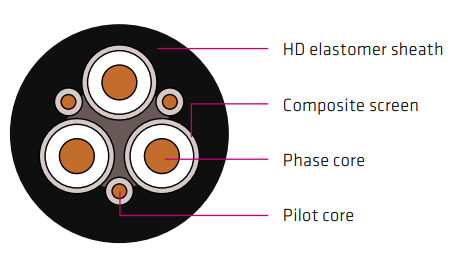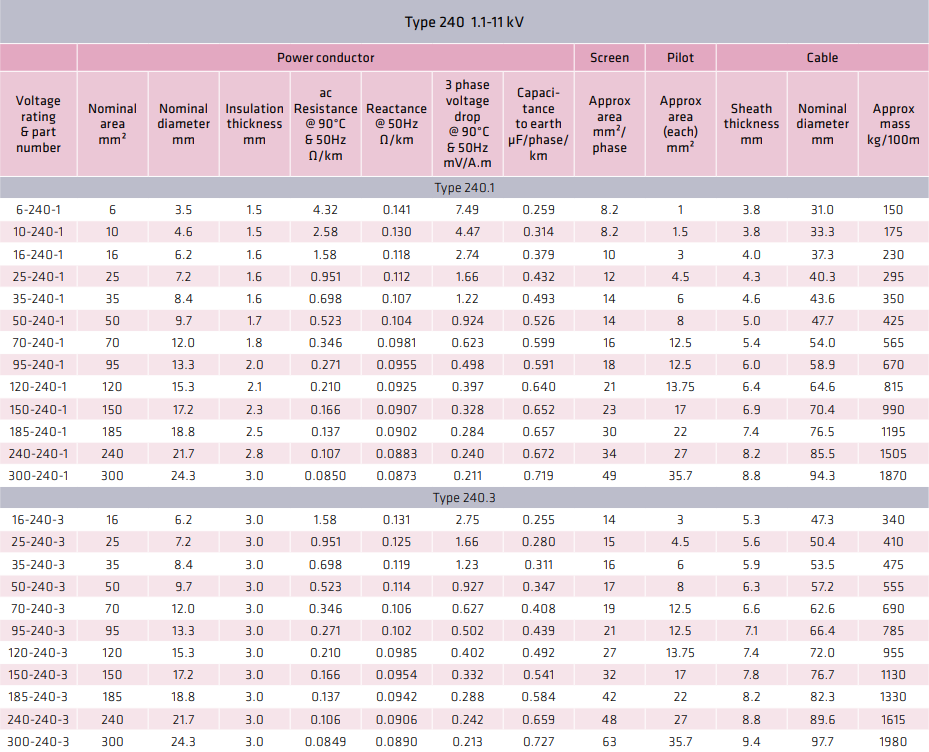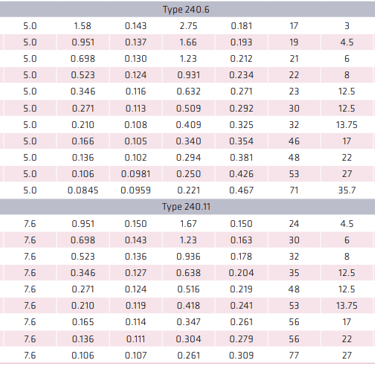📞+86 153 7530 2641 📧 hongjing.Wang@feichuncables.com

High-Performance Type 240 Metal Screened Power Cable with Three Pilot Conductors for 1.1/1.1 kV to 11/11 kV Feeder Applications
Discover the robust Type 240 cable featuring metal screened power cores and three separate pilot conductors. Engineered for 1.1/1.1 kV to 11/11 kV feeder connections—ideal for transformer-to-gate-end box, continuous miner, and pump cables—this design ensures reliable long-run pilot control protection without resistance limitations.
hongjing.Wang@Feichun
8/12/20259 min read


Introduction
The Type 240 cable family represents a pinnacle of engineering excellence in medium-voltage power transmission, specifically designed for demanding industrial applications requiring both power delivery and pilot control capabilities. These composite screened cables, manufactured to AS/NZS 1802 standards, feature three separate pilot conductors integrated within a robust metal-screened power core configuration, making them ideal for critical infrastructure connections across mining, industrial, and utility sectors.
The primary applications for Type 240 cables include feeder connections between transformers and gate-end boxes, continuous miner operations in underground mining environments, and pump feeder cables in remote locations. What distinguishes this cable family from conventional power cables is its sophisticated design that incorporates three pilot conductors, enabling long-run installations without compromising pilot control protection system resistance limitations.
The importance of metal screening and pilot conductors in high-voltage feeder cables cannot be overstated. In harsh industrial environments, electromagnetic interference (EMI) can severely compromise control systems and create safety hazards. The Type 240's composite screen design provides exceptional protection against EMI whilst maintaining the integrity of pilot signals over extended distances. This dual functionality ensures both reliable power transmission and precise control system operation, essential for applications where operational safety and efficiency are paramount.
Technical Specifications
Voltage Rating and Core Construction
The Type 240 cable family encompasses voltage ratings from 1.1/1.1 kV up to 11/11 kV, accommodating a wide range of medium-voltage applications. The cable features tinned copper power cores available in configurations ranging from three-core plus central pilot to more complex arrangements depending on the specific voltage and application requirements.
The conductor construction employs high-quality tinned copper, providing excellent electrical conductivity whilst offering superior corrosion resistance in challenging environments. The three separate pilot conductors are strategically positioned within the interstitial cavities of the cable design, each covered with elastomer and proofed tape to ensure long-term reliability and protection from environmental factors.
Metal Screen Design
The composite screen represents one of the most critical aspects of the Type 240 design, consisting of tinned annealed copper wire combined with polyester yarn. This configuration provides multiple benefits: effective earthing capabilities, electromagnetic interference shielding, and mechanical protection for the internal conductors. The screen design complies with AS/NZS 1802 standards, ensuring consistent performance across different manufacturers and applications.
The electromagnetic interference mitigation provided by the metal screen is particularly crucial in industrial environments where high-power equipment operates in close proximity to control systems. The screen effectively creates a Faraday cage around the power conductors, preventing external electromagnetic fields from interfering with pilot signals and protecting sensitive control equipment from power frequency electromagnetic fields.


Performance Characteristics
Electrical Properties
The electrical performance of Type 240 cables varies significantly across the different conductor sizes and voltage ratings available. For example, the 25-240-1 configuration (25mm² conductor area) exhibits an AC resistance of 0.951 Ω/km at 90°C and 50Hz, with a reactance of 0.112 Ω/km and a three-phase voltage drop of 1.66 mV/A.m. These values represent excellent electrical performance for medium-voltage applications.
Capacitance to earth values are carefully controlled across the range, with the 25-240-1 configuration showing 0.432 μF/phase/km. This relatively low capacitance helps minimise charging current requirements and reduces the risk of resonance phenomena in long cable runs. The precise control of electrical parameters ensures predictable performance across the entire cable length, essential for accurate voltage regulation and protection system coordination.
Mechanical Properties
Sheath and insulation thickness are carefully engineered to provide optimal protection whilst maintaining flexibility. The heavy-duty HD-85-PCP sheath material provides excellent resistance to mechanical damage, chemical exposure, and environmental factors. Insulation systems vary by voltage rating, with 1.1/1.1 kV cables using polyester conductor separator tape and proofed textile insulation tape, whilst higher voltage cables employ semiconductive screening for enhanced performance.
The flexibility characteristics of Type 240 cables make them particularly suitable for long-run installations where the cable must navigate complex routing paths. The cable maintains its flexibility even in challenging environmental conditions, with operating temperature ranges from -25°C to +90°C ensuring reliable performance across diverse climate conditions.
Environmental Resilience
Type 240 cables demonstrate exceptional environmental resilience, with fire retardant properties providing enhanced safety in industrial applications. The cables are designed for direct burial, duct installation, and aerial applications, with excellent resistance to water exposure including temporary submersion conditions.
Chemical resistance properties are particularly noteworthy, with the cable design providing very good to frequent exposure resistance against a wide range of industrial chemicals. This makes Type 240 cables ideal for applications in chemical processing plants, mining operations, and other industrial environments where chemical exposure is a concern.


Application Scenarios
Feeder Connection Between Transformer and Gate-End Box
One of the primary applications for Type 240 cables is the critical connection between distribution transformers and gate-end boxes in industrial facilities. This application requires exceptional reliability as any failure can result in significant production downtime and safety hazards. The three pilot conductors enable sophisticated control and monitoring systems to operate effectively over these connections, providing real-time status information and enabling rapid response to fault conditions.
The metal screening provides essential protection against electromagnetic interference from adjacent high-voltage equipment, ensuring that control signals maintain their integrity throughout the connection. The robust construction withstands the mechanical stresses associated with industrial environments whilst providing the electrical performance necessary for reliable power distribution.
Continuous Miner Cable for Underground Mining Operations
Underground mining operations present some of the most challenging environments for electrical cables. Type 240 cables excel in these applications due to their robust construction and reliable pilot conductor performance. Continuous miners require both substantial power for operation and sophisticated control systems for safe and efficient operation.
The three pilot conductors enable complex control functions including equipment positioning, cutting head control, and safety system integration. The metal screening provides essential protection against the harsh electromagnetic environment created by high-power mining equipment operating in confined spaces. The cable's resistance to mechanical impact and chemical exposure ensures reliable operation despite the demanding underground environment.
Feeder Cables to Pumps in Remote Locations
Remote pump applications often require long cable runs where traditional cables would suffer from excessive voltage drop or pilot signal degradation. Type 240 cables address these challenges through their optimised electrical design and integrated pilot conductors. The low resistance characteristics minimise voltage drop over long distances whilst the pilot conductors enable sophisticated pump control and monitoring systems.
The environmental resilience of Type 240 cables makes them ideal for outdoor pump applications where exposure to weather, chemicals, and mechanical damage is inevitable. The metal screening provides essential protection for both power and control circuits, ensuring reliable operation of critical pumping systems.
Long-Run Pilot Control Protection Without Resistance Limitations
The integrated pilot conductor design represents a significant advantage in applications requiring long-run control circuits. Traditional approaches using separate control cables often suffer from excessive resistance over long distances, leading to control system performance degradation or failure. The Type 240 design eliminates these limitations by providing low-resistance pilot conductors integrated within the same cable as the power conductors.
This integrated approach simplifies installation, reduces material costs, and provides enhanced reliability through reduced connection points. The metal screening ensures that pilot signals maintain their integrity even in high-noise electromagnetic environments, essential for reliable control system operation.


Installation and Maintenance
Best Practices for Cable Laying and Termination
Proper installation of Type 240 cables requires careful attention to several critical factors. Cable routing must consider the minimum bend radius requirements to prevent damage to internal conductors and maintain the integrity of the metal screen. Termination procedures must ensure proper screen earthing to maintain electromagnetic interference protection whilst avoiding circulating currents that could cause heating.
During installation, particular attention must be paid to the pilot conductors to prevent damage that could compromise control system operation. Proper cable pulling techniques and appropriate pulling tensions are essential to maintain the cable's structural integrity throughout the installation process.
Pilot Conductor Testing and Protection System Integration
Comprehensive testing of pilot conductors is essential both during installation and as part of ongoing maintenance programmes. This includes verification of conductor continuity, insulation resistance testing, and signal integrity verification. Protection system integration requires careful consideration of pilot conductor characteristics to ensure proper coordination with control and monitoring equipment.
Regular testing schedules should be established based on the criticality of the application and environmental conditions. Advanced testing techniques including time-domain reflectometry can provide early warning of developing faults, enabling proactive maintenance strategies.
Regular Inspection and Lifecycle Management
Effective lifecycle management of Type 240 cables requires regular inspection programmes tailored to the specific application environment. Visual inspections should focus on cable sheath condition, termination integrity, and any signs of mechanical damage or chemical attack. Electrical testing programmes should include insulation resistance testing, partial discharge monitoring where appropriate, and pilot conductor performance verification.
Documentation of inspection results and maintenance activities provides valuable data for optimising maintenance schedules and predicting cable lifecycle requirements. This proactive approach helps prevent unexpected failures and optimises overall system reliability.


Advantages of Type 240 Cable
Enhanced Safety with Metal Screening
The metal screening system provides multiple safety benefits beyond electromagnetic interference protection. The screen serves as an effective earth fault protection system, providing a low-impedance path for fault currents that enables rapid fault detection and clearance. This enhanced safety capability is particularly important in industrial environments where personnel safety is paramount.
The screening system also provides protection against external damage, helping to prevent faults that could result in dangerous conditions. The integrated design ensures that safety benefits are maintained throughout the cable length without relying on separate protective systems that could fail independently.
Reliable Pilot Control Over Extended Distances
The integrated pilot conductor design enables reliable control system operation over distances that would be impractical with conventional approaches. The low resistance and well-controlled electrical characteristics of the pilot conductors ensure that control signals maintain their integrity regardless of cable length within reasonable limits.
This capability enables system designers to locate control equipment and field devices optimally without being constrained by control circuit limitations. The result is more flexible system designs and improved overall system performance.
Versatility Across Mining, Industrial, and Utility Sectors
Type 240 cables demonstrate remarkable versatility across diverse applications. From underground mining operations to petrochemical facilities to utility distribution systems, these cables provide consistent performance and reliability. This versatility stems from the robust design and comprehensive range of conductor sizes and voltage ratings available.
The standardised design approach means that maintenance personnel can develop expertise that applies across multiple applications and environments, reducing training requirements and improving maintenance effectiveness.
Compliance with International Standards
Compliance with AS/NZS 1802 ensures that Type 240 cables meet rigorous performance and safety requirements recognised throughout Australia and New Zealand. This compliance provides confidence in cable performance whilst ensuring compatibility with existing systems and practices.
The standardised approach also facilitates system design and specification, enabling engineers to specify cable requirements with confidence in the resulting performance characteristics.
Frequently Asked Questions
Q: What are the main differences between Type 240.1, 240.3, 240.6, and 240.11 variants?
A: The numerical suffix indicates the voltage rating in kV. Type 240.1 is rated for 1.1/1.1 kV applications, 240.3 for 3.3 kV, 240.6 for 6 kV, and 240.11 for 11 kV systems. Higher voltage variants feature thicker insulation and enhanced screening systems to handle the increased electrical stress.
Q: How do I determine the appropriate conductor size for my application?
A: Conductor sizing depends on several factors including load current requirements, voltage drop limitations, and short-circuit withstand requirements. The technical specification table provides resistance and reactance values that can be used for voltage drop calculations. It's recommended to consult with a qualified electrical engineer for complex applications.
Q: What is the maximum cable length for maintaining pilot control system performance?
A: The maximum length depends on the specific control system requirements and pilot conductor resistance limitations. However, the low resistance pilot conductors (typically 1-35.7 mm² depending on cable size) enable much longer runs than conventional approaches. Specific applications should be evaluated based on control system specifications.
Q: Can Type 240 cables be directly buried without additional protection?
A: Yes, Type 240 cables are designed for direct burial applications. The heavy-duty HD-85-PCP sheath provides excellent protection against moisture, soil chemicals, and mechanical damage. However, local installation practices and soil conditions should be considered when determining if additional protective measures are warranted.
Q: What maintenance is required for the metal screening system?
A: The metal screening system requires periodic testing to ensure proper earthing and continuity. This typically involves resistance testing and verification that screen connections remain intact. Visual inspection of terminations for corrosion or damage should also be performed regularly.
Conclusion
The Type 240 cable family represents a sophisticated solution for demanding medium-voltage applications requiring both reliable power transmission and integrated pilot control capabilities. The combination of robust metal screening, high-quality copper conductors, and three separate pilot conductors creates a versatile cable system suitable for a wide range of industrial applications.
Key benefits include enhanced electromagnetic interference protection, reliable pilot control over extended distances, excellent environmental resilience, and compliance with recognised Australian and New Zealand standards. These characteristics make Type 240 cables particularly suitable for transformer feeder connections, continuous miner applications, remote pump installations, and other critical industrial systems.
For applications involving long cable runs, harsh environmental conditions, or requirements for integrated pilot control, Type 240 cables offer significant advantages over conventional cable systems. The comprehensive range of conductor sizes and voltage ratings ensures that appropriate solutions are available for most medium-voltage applications whilst maintaining consistent performance characteristics across the entire range.
When selecting Type 240 cables, consideration should be given to specific application requirements including load characteristics, environmental conditions, installation methods, and control system requirements. Proper installation and maintenance practices are essential to realise the full benefits of these advanced cable systems and ensure long-term reliable operation in critical industrial applications.
How to Reach Us
Get in Touch
SiteMap
Product Catalogue
Reeling Cable
Festoon Cable
Shore Power Cable




Scan to add us on WeChat
